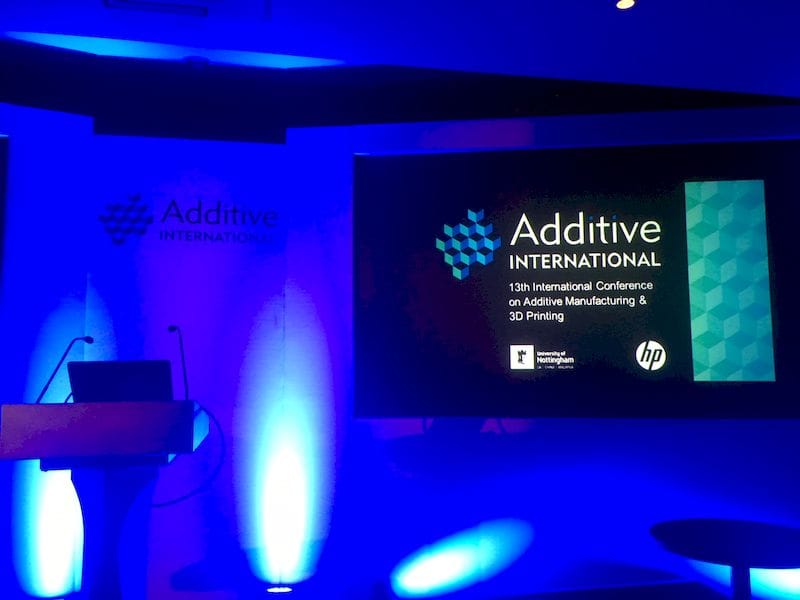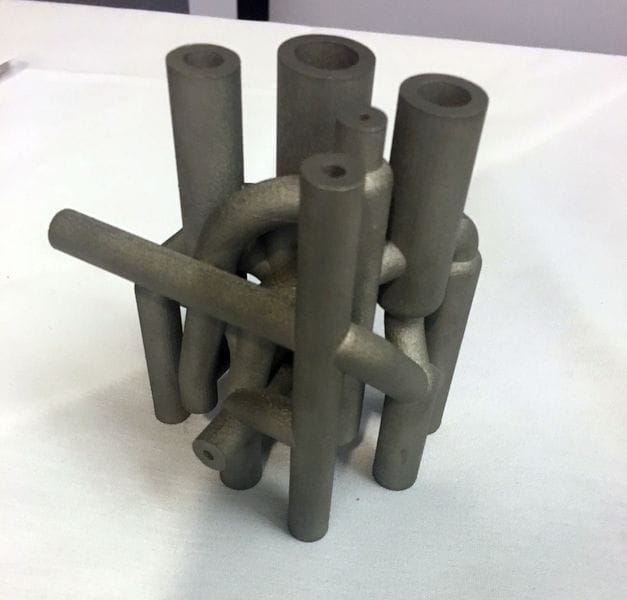
My annual pilgrimage to Nottingham for the Additive International conference happened this week (10th-12th July).
As I may have mentioned once or twice previously, I am a big fan of this event, due to the huge amount of new information I always discover during the three days, not to mention the networking opportunities that always throw up plenty of off-the-record insights. This year is proving to be no different.
The Nottingham event, renamed and rebranded for 2018 as “Additive International” under the organisation of Added Scientific and the company’s rapidly growing team is a permanent calendar fixture for many people in the additive manufacturing sector, me included. There are always new faces, however, and at the Nottingham Belfry venue, this event has reached capacity in 2018, according to Sophie Jones, Managing Director of Added Scientific.
For some years now, the event is split into two – with day one offering a pre-conference day full of updates on UK AM research activities. I have always found this to be extremely valuable in that it provides keen insights into trends around AM, the often overlooked challenges and issues and where the next breakthroughs are happening. Traditionally, this pre-conference conference has highlighted a great deal of academic work, but this year saw a change of pace. The day was run in collaboration with Innovate UK, which is part of UK Research and Innovation (UKRI) the national funding agency investing in science and research in the UK.
Under the banner “Business Innovation in Additive Manufacturing” the day was dedicated to highlighting 32 of the 50 AM projects that Innovate UK is supporting. You may wonder why not all 50? I’ll admit it did occur to me, too, but according to Robin Wilson, who heads up Innovate UK, fitting 32 into one day was quite stressful enough. And as the day unfolded, I took his point. Sessions were dedicated to specific areas of research, specifically:
-
New Additive Manufacturing Processes
-
Med Tech
-
Post Processing
-
Inspection Systems
-
New Materials / Conductive Components
-
Large Scale / Construction
-
Tooling / Hybrid Processes
-
Aerospace – Large Project.
Each session then started with a 10-minute presentation, with a headline project that provided insight into this area of research, development and commericalisation progress. The session then progressed to a series of 2-minute pitches highlighting the progress of other projects in this area. It was fast paced and, barring a singular mishap, slick in operation providing some key insights. The 2-minute presentations all followed the same formula – throwing a spotlight on the key objectives of each project, the progress that has been made to date, future goals and how the project contributed to the UK National AM strategy. It really worked very well and fulfilled the self-imposed remit of sharing information and highlighting some of the UK’s most advanced AM research heading towards commericalisation.

Obviously there was a huge amount of IP beneath these glossy 2-minute presentations. The representatives of each project, usually fronting for wider partnerships, had been asked “to share as far as possible” but there was always an awareness that there was much more going on beneath the surface. From a business point of view – that’s a given and was generally well accepted across the audience.
One observation across the day was the high number of these projects that are due to end in March 2019. In line with the Brexit deadline. It was never explicitly said out loud, but the implication was clear and as in many other areas across UK industry, it threatened a darkening cloud with no clear solution.
Two other key themes that emerged time and again across the day, and across sessions, were automation and connectivity. The focus on these areas is actually diverse but uniformed in the call to action to ensure improvements in both for successful AM implementation – specifically in-house but also across supply chains.
It would be impossible to cover every project presented during the day in this post – to give you an idea, the shorthand notes I took during the event yesterday totalled almost 4,000 words. So here I am going to highlight a couple of projects that really stood out for me, and hopefully follow up with a more comprehensive project overview post-conference.
I think the most inspirational project presented was the collaboration between Andiamo, Additive Flow and Barts Health NHS Trust. The name of the project — CON-DIG — does not do it justice, but hints at the focus, namely Connected Digital Additive Manufacturing to develop the interface between product design, AM systems and in-process data for a feedback loop to improve both design and production operations.
For this particular collaboration the focus is to “create data driven, family-centred healthcare product design” with a direct impact on real, young, human lives through the accelerated, patient-specific development and manufacture of 3D Printed orthotics for children & adolescents. As Alexander Pluke, from Additive Flow, explained it: Barts has 1000s of patients that fit into this category worldwide, and while each case may have commonality, every one of them requires different treatment through the application of the orthotic providing different amounts of force over time. Conventionally, these orthotics take six months to produce from consultation and measurement through to fitting on the child or young person. Thus, often they end up being redundant by the time they are ready, due to the inconvenient fact that children tend to grow over a six month period.
And this is the exciting part of this project, the one that really makes a difference, in that Andiamo is able to accelerate the manufacturing process from 6 months down to 1 week. Moreover, by using functional graded materials and functionally grading the orthotic in a way that is targeted to the specific requirements of each child’s medical issue it becomes easy to see why AM is such a good fit here.
Innovate UK was obviously proud to be funding this project which is demonstrably improving lives and “empowering children to be children” by receiving BETTER treatment, faster. The project is currently half way through its 18 month span, the goal is to roll it out. It’s one of those applications where you want to stand up and cheer because it’s a real application, applied in a realistic way and DOING GOOD; but I had to stop myself, you know, being at a professional conference and all.
The other project that really stood out for me was presented by Dan Mace of Archipelgo in the “New AM Processes” session. He introduced his two-minute pitch with three words, but it got a great deal of attention. He said: “We jet glue.” The project is called “SmartDrop” and the premise is a connected digital additive manufacturing platform, using inkjetting technology. In a nutshell, Smartdrop is a non-contact jetting process for viscous liquids targeting applications that include shaped and programmable adhesive, efficient coatings and primers.
The objectives of this project include creating a SmartDrop prototype system, then subsequently place this system at a lead customer site, with the ultimate goal of commissioning a Smartdrop manufacturing system facility. To date the prototype system has progressed well, and has demonstrated that the technology is scalable at narrow width. Moreover, options for manufacturing have been identified. The project is running until 2020, and definitely one to keep an eye on — in the UK and globally.
What the Innovate UK day achieved more than anything else, at least for me, was to to serve to highlight the tremendous rate of growth taking place in the 3D printing sector, it certainly seems to have tipped into exponential. The ideas, the funding, the projects and the collaborations just here in the UK are expanding at a tremendous rate and that is certainly being mirrored across Europe, the US, Canada, Australia and China, if the rest of the conference was anything to go by.
That round up will follow.

